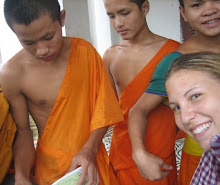It seems the Democratic Republic of Congo has followed me...my grandfather worked there in the 1950s and my aunt was even born there. Fifty years later, when interning at WITNESS I worked on a project for a DRC-based NGO working on demobilizing child soldiers, and then while interning at the UN during grad school, I found myself in the elevator with Joseph Kabila- then (and still) president. It was only a matter of months until I made my first trip there and to my surprise, within the next year and a half, my 2nd and 3rd trip.
Working there as a filmmaker for a humanitarian organization, I had the chance to be working on the field most of the time and interact with locals from whom I heard both funny stories and others that left me perplexed. While I got use to being pointed out as the “muzungu” (white person) everywhere I went, the reactions varied from curiosity, to laughs, to occasional fear. Some kids would actually start running or crying at my sight!.. My Congolese friends explained that besides the possibility that they might be coming across a white person for the first time (and probably wondering what kind of disease had made me lose my color) their fear stemmed from stories they might have heard… of the white cannibals that eat human flesh. Ironic right? To think that those myths we might have heard at some point about Africans, be reflected back to us.
The sad part is that these perpetuated myths are not so far from the truth.. While the white man now comes in paternalistically as Congo’s “savior”, coming to develop the country, he (and it really was just men) was its tyrant for many decades.
It is only after reading King Leopold's Ghost by Adam Hochschild that I now have a better understanding of where all these stories come from. The Heart of Darkness, made famous by Joseph Conrad (which in turn inspired the film Apocalypse Now) depicts Congo as it was under its owner, the King of Belgium, Leopold. The term “owner” is deliberate as indeed Congo started not as a Belgium colony but as the King’s private property.
The particular myth of white men eating human flesh (which my Congolese friends truly believe as fact) comes from the terrible history of the Congo under Leopold, who it is interesting to note, never set foot in the country that made his fortune.
Henry Morton Stanley, who is famous for his expedition to find David Livingstone, helped Leopold establish his claim on the Congo. While Morton was very harsh with his porters, who died by the hundreds along his expeditions, it actually pales in comparison to the Belgium officers (though it is no less excusable).
Indeed, the way King Leopold made his fortune was through the collection of rubber that grew wildly in the Congolese jungle and was in high demand at the time throughout Europe. The Belgiums forced Congolese men to spend days in the jungle to fulfill their rubber quotas. This has enormous repercussions. Agriculture was abandoned, as men did not have time to work their fields, leaving little food and entire villages starving; families were separated for months, and Congolese started controlling their population, not wanting to put more children on this Earth, that would live a humiliating life, serving the white men. Women would also be kidnapped and held hostage by the Belgiums in order to force men to go to work. Officers would routinely burned and killed entire villages to spread their message to others that that was what could happen if you did not submit to the rubber regime.
On those occasions, European officers demanded proof that each cartridge used by their soldiers had been used to kill someone and not “wasted”. The standard proof was a right hand from the corpse…except that often soldiers did use a cartridge to hunt an animal and cut off a hand from a living man (and even children!!) to bring back. On some occasions, the sadistic officers cut other body parts too.
As a result of King’s violent rule over Congo, it is estimated that 10 million Congolese died– about 50% of the population at the time.
We were shocked to hear about hands and feet being cut off by Charles Taylor- backed rebels in Sierra Leone during the country’s violent civil war. Another lasting image of Africa ingrained in our brains, about these “savages”. No doubt that these rebels are indeed savages. But we should be careful about not stereotyping it as an “African” thing and look back at our own Western history.
History, we know, is written by the victors. And Belgiums seem to have gone into collective amnesia and just skip over that sad heritage of their past. But history explains the present and we must not forget.
This sad episode does have a positive effect today, one well-described in Hochschild's book.
The campaign to reveal the truth behind Leopold's atrocities in the Congo led by Roger Casement, and a former shipping clerk E.D. Morel, became the first mass human rights movement. It carved the path for successors like Amnesty International and Human Rights Watch that assure that we never be blind to these inhumane acts again.
Friday, September 11, 2009
Democratic Republic of Congo - part I
Subscribe to:
Post Comments (Atom)

I'll recommend another book
ReplyDelete''Du Sang sur les lianes''
You can also get dcumentations on the current saga about the Hergé book ''Tintin au Congo''
I have a copy of a speach to the ''Religieux'' who where setting their foots on Congo's soil.
When you put in balance the colonisation was not grimm, some positive inputs where there also.
Thanks for the recommendations!
ReplyDelete